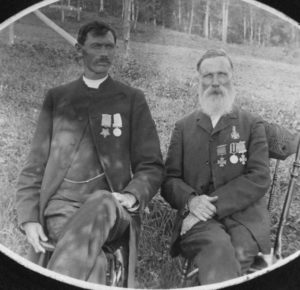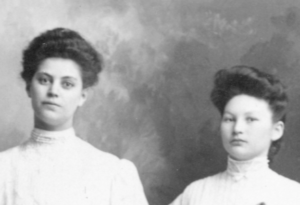
Click on the “play” button to hear the diary episode read aloud, and click on the green tab 1 to learn more about a word or phrase.
“Pray” 2 “Lift up your eyes and look on the fields 3 – “Go” 4
Matt. 9:38 for they are which already to harvest.” Mark 16:15
The Canadian Church Missionary Association
IN CONNECTION WITH
THE CHURCH MISSIONARY SOCIETY
Toronto
Jeremiah Johnston 5 was born November 20th, 1860, at St. Peter’s 6 [on the Red River in Manitoba]. His father was a Sadler 7 of English descent who died when Mr. Johnston was two years old. His mother was a half breed 8 Cree 9 from the York Factory 10 region, around Hudson Bay-Oxford Gull Lake. Though his mother was born a heathen 11 , when her mother, who was left a widow, brought her children to St. Peter’s she became a Christian 12 , and Jeremiah was brought up Christian. All his siblings — two older brothers and one older sister — died after they were grown up: John at twenty, David at twenty-four, his sister in childbirth. As his brothers were dying, Jeremiah and his mother prayed that God would take him last, and use him.
Jeremiah spoke Cree and English from boyhood. He was educated at the Church Missionary School 13 and St. John’s College 14 and took a special year-long course for Indian mission work 15 . At fourteen, he was confirmed by the Bishop of Rupert’s Land 16 at St. Peter’s (This was Archdeacon Cowley of McKay 17 , now of Saskatchewan). In 1880 he married Mary Macleod 18 of Claudeboie. Her father, a Scotchman, is a farmer, and is still living at Wakefield. Of the Johnston’s ten children, six are dead, four still alive: Florence, Samuel, Beatrice, and Isabel. Since 1880 Johnston has taken part in Church work: after his marriage he was elected a vestryman 19 , though he started long before as a boy in the choir. He was then People’s Churchwarden 20 for 4 years before going out as a Catechist 21 to Jack Head 22 .

In September 1884 he left with the Red River contingent of voyageurs for the Sudan 23 , under Col. Kennedy of Winnipeg 24 (Holy Trinity Church). He returned in March 1885, and received two bronze medals from Khedive 25 , as well as a Silver medal from the British Government inscribed ’91 Boatmen J. Johnston Manitoba (The Nile 1884-85).
While always inclined to be religious his spiritual life deepened while abroad. A native on the Nile asked for a bible and Jeremiah gave him his own. He was one of four in his crew who did not drink, and was chosen foreman during the illness of the regular foreman.
Near Dongala 26 , on the Nile, he was meditating quietly when his eyes rested on a thorn bush 27 of the desert, its sharp points baked in the sun.
After his return, Johnston was reelected a vestryman, and then became a communicant 28 and was eventually chosen people’s warden. He became more and more interested in active Christian work and felt that he ought not to be in the light when many of his native brethren were in darkness 29 . He went to Mr. Anderson 30 and told him that he would like to go into the work of preaching the gospel. The Lord opened the Way: just at this time there was a vacancy at a mission at Jack Head, on the West Shore of northern Lake Winnipeg. The Committee accepted him, and he went the following spring.
In July 1890, Johnston set out in a sailboat with his wife, three children, and provisions. They were also accompanied by Archdeacon Phair 31 and a pilot. On the journey there was a wonderful escape from capsizing when Mrs. Johnston saved the pilot with one finger, on the Hole River 32 . They travelled to Loon Island 33 and the Blood Vein river 34 . There, standing on the Rock, Johnston preached to the Indians. Two years afterwards, his labours saw fruit, when a young girl, thought to be dying, was baptized 35 and recovered. However, the Indian Agent 36 , a Roman Catholic, said Mr. Johnston of the Church of England could not legally baptize anyone 37 , and her parents got her back to the medicine tent 38 .
After being ordained 39 , Johnston returned in 1896 and baptized nine converts.
In summer 1892, Mr. and Mrs. Johnston and their three children returned to the mission with winter supplies. On their trip, waves washed over the deck until it filled the boat “Sunbeam,” which sank in the harbour of Grouse Island 40 . The wind changed, and drove it into the harbour, where the family went ashore and worked all night to save the boat, but it was so badly damaged they could not go on. They spent 11 snowy, rainy days on this island, with only a tent for shelter.
In 1895 Johnston was called by committee to take a Special Course for ministry, and was ordained Whitsunday 41 1896. He took a special trip to Jack Head and Blood Vein and then he was appointed to Long Sault 42 and arrived on July 14th. There, the family camped on the mission property 43 while building a house. A cyclone swept everything in different directions.
Mr. Bagshaw 44 lived near by. The House and Church 45 were built in 1896, finished in about September, on a lot of about five acres cleared by Mr. Johnston.

